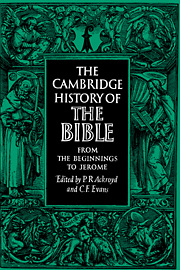2 - THE BIBLICAL SCRIPTS
from I - LANGUAGE AND SCRIPT
Published online by Cambridge University Press: 28 March 2008
Summary
This section is subdivided into four: (1) Early Hebrew, (2) Square Hebrew, (3) Greek and (4) Latin, and three minor sections: (5) Syriac, (6) Coptic, (7) Ethiopic.
EARLY HEBREW
This term is employed in distinction from that of ‘Square Hebrew’ (see pp. 16 f.) which was the parent of the modern Hebrew alphabet, The Early Hebrew alphabet is the original script of nearly the whole of the Old Testament. It was the script of the Hebrew kings and prophets, and was employed by the ancient Hebrews in the pre-exilic period, that is, in the first half of the first millennium B.C., but its use in a limited measure continued into the fifth to the third centuries B.C., and lingered on till much later times. The writing on Jewish coins and the Samaritan alphabet were direct derivatives of the Early Hebrew script.
Accurate knowledge of the Early Hebrew alphabet is an achievement of the last decades. Winckler, Naville, Benzinger, Jeremias, Grimme, and other eminent scholars of the last hundred years argued that cuneiform was the official mode of writing of the ancient Hebrews up to the time of Hezekiah (c. 700 B.C.). Some parts of the Bible were supposed to have been written in cuneiform characters on clay tablets, and certain biblical terms have been interpreted accordingly. Some scholars even denied that alphabetic writing was practised in Palestine before the Persian period. Cowley, for instance, suggested that it was Ezra who, with the assistance of his colleagues, translated the cuneiform documents into Hebrew, and wrote the result down in simple Aramaic characters.
Keywords
- Type
- Chapter
- Information
- The Cambridge History of the Bible , pp. 11 - 29Publisher: Cambridge University PressPrint publication year: 1970

